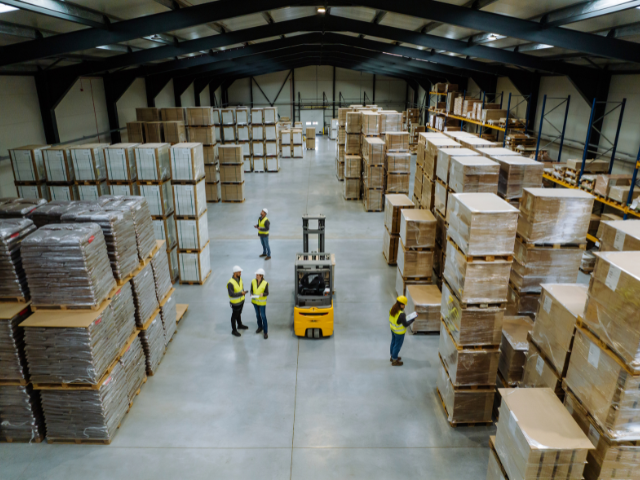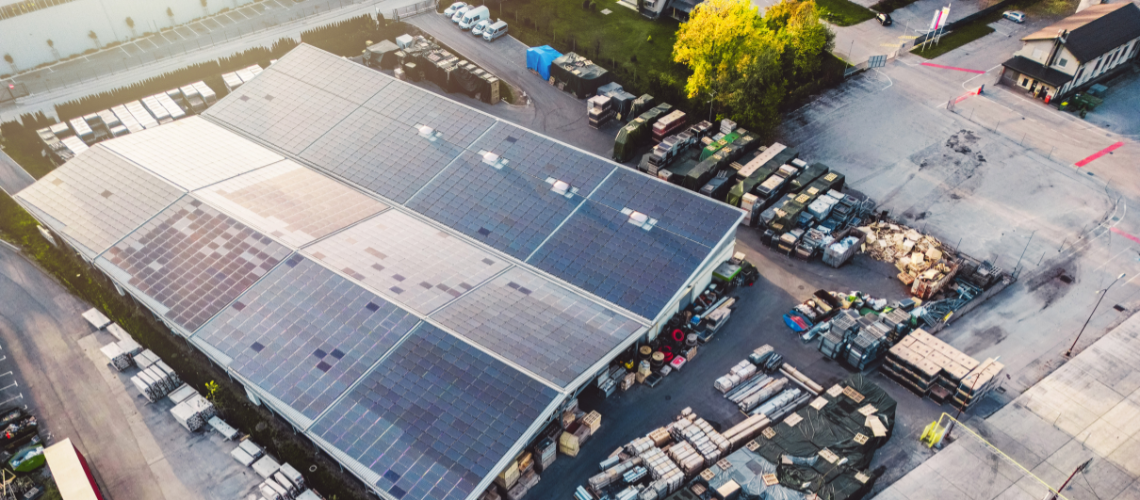Warehouses and logistics facilities are under growing pressure to reduce energy consumption, meet net zero targets, and cut operational costs – all while ensuring uninterrupted operations and maintaining compliance. Smarter lighting installations represent one of the most straightforward ways to achieve these objectives.
Why Warehouse Energy Efficiency Matters
Warehouses are among the most energy-intensive commercial buildings in the UK. According to Meteor Space, heating and lighting typically account for 76% of total energy use in warehouses. The Carbon Trust reports that lighting alone can represent between 65% and 95% of energy consumption in ambient warehouses.
Industry data shows that average warehouse electricity use exceeds 8,800 kWh per month, with gas usage over 20,000 kWh, resulting in an annual energy draw of more than 100 MWh. Across the UK, the warehousing sector consumes 3.2 TWh of electricity every year – the equivalent of powering 41 square kilometres of floor space – and contributes approximately 698,000 tonnes of CO2 emissions.
With the UK Government’s legally binding net zero target for 2050 and interim milestones of 68% CO2 reductions by 2030 and 78% by 2035, warehouse operators are under growing regulatory and financial pressure to decarbonise.
Common Warehouse Lighting Challenges Driving Energy Costs
Warehouses often face a range of challenges that contribute to excessive energy consumption and inflated carbon footprints:
- Outdated lighting systems reliant on inefficient T5, fluorescent, or HID fixtures.
- Lighting left on 24/7, including in low-traffic or unoccupied areas.
- A lack of smart lighting controls such as PIR sensors, timers, or daylight harvesting.
- Escalating energy costs, amplified by volatile UK market conditions and higher electricity vs gas tax burdens.
- Increasing requirements for environmental reporting, carbon reduction plans, and compliance with CRC/ECO initiatives.
- Maintenance issues, with frequent lamp failures, ballast faults, and unplanned disruptions.
- Poor lighting uniformity, creating dark zones in aisles, racking, and loading areas—heightening safety risks and slowing operations.
- Complex projects that require lighting upgrades alongside warehouse expansions or reconfigurations.
- Difficulties integrating lighting improvements with data, IoT, and automation systems.
Limited internal expertise to deliver compliant, energy-efficient lighting upgrades.

The Opportunity Of Smarter Lighting
Replacing outdated lighting with high-performance LED solutions delivers significant operational and environmental benefits. Modern LED systems typically reduce lighting energy consumption by 50% to 70%, while improving light quality, system longevity, and maintenance requirements.
Integrating smart lighting controls – including motion sensors, daylight-responsive dimming, and automated scheduling – can further reduce lighting-related energy use by at least 10% (pecnw.com).
With payback periods of just 2–4 years in typical warehouse settings, the case for LED retrofits is compelling – offering both cost savings and rapid progress towards environmental targets.
The Carbon & Cost Payback For Warehouses
- Full LED retrofits and smart lighting controls can reduce energy use by up to 70%.
- Lighting upgrades can generate savings of £20,000 to £50,000 annually for a 10,000 m² warehouse.
- The UK Climate Action Tracker states that achieving net zero by 2050 is viable – but only if immediate, practical measures are taken
- Improved lighting also enhances ESG scores, improves safety, attracts grant opportunities, and reduces insurance risk.

DTE's Expert Opinion - Chris Stock
“From working with warehouses and logistics operators across the UK and Europe, it’s clear that lighting is one of the most overlooked opportunities to drive down operational costs while improving performance. Many sites delay upgrades due to concerns about disruption, but with the right planning, lighting improvements can happen smoothly and deliver immediate results.
In my view, smart lighting is no longer a luxury – it’s essential for any operation looking to improve efficiency, meet sustainability commitments, and create a safer, more productive workplace. The returns are measurable, the payback is rapid, and the long-term benefits are significant. With experienced planning and technical expertise, even the most complex warehouse environments can modernise lighting with minimal downtime.”
Recommendations For Warehouse Operators
Every warehouse is unique, but a few consistent steps help ensure success when planning energy-efficient lighting upgrades:
- Begin with a site-specific energy audit and lighting survey to assess current performance.
- Identify areas with outdated, inefficient fixtures and poor light distribution.
- Consider both LED replacements and smart controls to maximise energy savings.
- Integrate lighting improvements with wider warehouse technology plans, including automation and IoT.
- Plan upgrades around operational schedules to minimise disruption and maintain productivity.

Next Steps For Warehouse Operators
For warehouse operators aiming to reduce energy use, improve environmental performance, and control costs, smarter lighting upgrades are a proven first step.
Many businesses begin with a tailored energy audit to benchmark current lighting performance and identify opportunities for improvement. From there, experienced project management and phased installations help ensure minimal operational disruption while maximising energy and cost savings.
Lighting upgrades support wider business objectives – including progress towards net zero, improved ESG credentials, and reduced operational risk – making them one of the most practical, high-impact investments for modern warehouses.
For those considering improvements, working with experienced partners to plan and deliver these upgrades can ensure technical compliance, operational continuity, and long-term energy savings.
Speak With An Expert
Submit your details below and we’ll be in touch.


